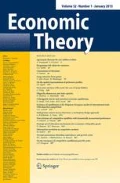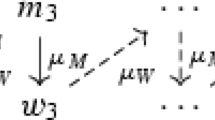Summary
This paper considers the incentives confronting agents who face the prospect of being matched by some sort of random stable mechanism, such as that discussed in Roth and Vande Vate (1990). A one period game is studied in which all stable matchings can be achieved as equilibria in a natural class of undominated strategies, and in which certain unstable matchings can also arise in this way. A multi-period extension of this game is then considered in which all subgame perfect equilibria must result in stable matchings. These results suggest avenues to explore markets in which matching is organized in a decentralized way.
Similar content being viewed by others
References
Blair Ch(1988) The lattice structure of the set of stable matchings with multiple partners. Math Operations Res 13: 619–628
Crawford VP, Knoer EM (1981) Job matching with heterogeneous firms and workers. Econometrica 49: 437–450
Gale D, Shapley L (1962) College admissions and the stability of marriage. Am Math Monthly 69: 9–15
Gale D, Sotomayor M (1985) Ms. Machiavelli and the stable matching problem. Am Math Monthly 92: 261–8
Kamecke U (1989) Non-cooperative matching games. Int J Game Theory 18: 423–431
Kelso AS Jr, Crawford VP (1982) Job matching coalition formation, and gross substitutes. Econometrica 50: 1483–1504
Knuth DE (1976) Mariages stables. Montreal, Les Presses de l'Universite de Montreal
Mongell S, Roth AE (1990) Sorority rush as a two-sided matching mechanism. Am Econ Rev (forthcoming)
Roth AE (1982) The economics of matching: stability and incentives. Math Operations Res 7: 617–628
Roth AE (1984a) The evolution of the labor market for medical interns and residents: a case study in game theory. J Political Econ 92: 991–1016
Roth AE (1984b) Misrepresentation and stability in the marriage problem. J Econ Theory 34: 383–387
Roth AE (1985) The college admissions problem is not equivalent to the marriage problem. J Econ Theory 36: 277–288
Roth AE (1989) Two sided matching with incomplete information about others' preferences. Games Econ Behav 1: 191–209
Roth AE (1990a) New physicians: a natural experiment in market organization. Science (forthcoming)
Roth AE (1990b) A natural experiment in the organization of entry level labor markets: regional markets for new physicians in the U.K. Am Econ Rev (forthcoming)
Roth AE, Sotomayor M (1990) Two-sided matching: a study in game-theoretic modelling and analysis. Econometric Society Monograph Series, Cambridge University Press (forthcoming)
Roth AE, Vande Vate JH (1990) Random paths to stability in two-sided matching. Econometrica (forthcoming)
Author information
Authors and Affiliations
Rights and permissions
About this article
Cite this article
Roth, A.E., Vande Vate, J.H. Incentives in two-sided matching with random stable mechanisms. Econ Theory 1, 31–44 (1991). https://doi.org/10.1007/BF01210572
Received:
Issue Date:
DOI: https://doi.org/10.1007/BF01210572




